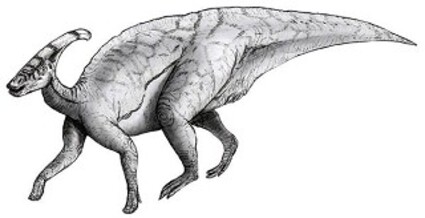First ever dinosaur fossil discovered in Oregon
Last updated 12/4/2018 at Noon
The fossilized toe bone of a dinosaur has been discovered among a bunch of ammonite fossils over near Mitchell.
This all took place back in 2015, but as you'd expect with a science that deals with things from as far back at 100 million years ago, the news tends to get out sort of casually.
According to a story filed by Kale Williams/The Oregonian/OregonLive on November 20, the discovery came about in 2015 when Greg Retallack, professor of Earth Sciences at University of Oregon (U of O), was in Central Oregon, leading a field expedition of students looking for fossilized plants near the town of Mitchell at a hot spot for ancient rocks called the Hudspeth Formation.
No one really expected to stumble across a dinosaur because no one had done so in the hundred or more years paleontologists like Thomas Condon - who started the department of geology at U of O - were searching among the marine and terristial fossils in the Hudspeth Formation.
The bone was discovered by one or more of the students on Retallack's expedition and they were probably wondering what it was (after all they were out in the Mitchell hills looking for plant fossils), but as soon as their fearless leader saw it, he knew. Oh, boy did he know! And when opportunity showed itself in the life of what is always a busy one for a professor of science, he published his find in the Journal of Vertebrate Paleontology in 2015.
After you've read the publication, take the time to read dear old Professor Condon's book, "Two Islands." You'll learn of the islands and ancient seas of today's Blue Mountains and Siskiyous 100 million years ago. It was on those spots of dry land that are known today as the Cordilleran Thrust Belt those ornithopod dinosaurs lived.
Ornithopods are dinosaurs in the clade - a group of organisms consisting of a common ancestor that started out in life as small, bipedal running grazers, that grew in size and numbers until they became one of the most plentiful groups of herbivores (plant eaters) in the Cretaceous world.
Their major evolutionary advantage was the progressive development of a chewing apparatus that became the most sophisticated ever developed by a non-avian dinosaur, even rivaling that of today's domestic cow. They reached their highest numbers in the duck-billed dinosaurs (hadrosaurs). Then the powers of evolution hit them hard, and they were wiped out by the Cretaceous/Paleocene extinction events. They are known from all seven continents, but are rare in the Southern Hemisphere.
In that the toe bone from the Hudspeth Formation orinothopod was found on top of a pile of ancient, fossilized ammonite fossils, it's thought the animal was probably grazing on the shoreline of the ancient seaway and either died or was killed by a predator. Its bones scattered - including a leg and foot - coming to rest on top of a bunch of ammonites, which also died, and the whole pile slowly fossilized.
For this old naturalist whose mentor was Phil Brogan - one of Oregon's great writers and geological teachers, and author of "East of the Cascades" - this find was remarkable. I'm hoping my 90-year-old bones and the stuff holding them together will still be functioning next spring, because I'd like to get as many of my old OMSI pals together as I can locate and all of us (and their kids and grandkids) go on an expedition to Mitchell countryside and try to find the rest of Professor Retallack's ornithopod, or maybe a Pterosaur (flying dinosaur) from the same period.

















Reader Comments(0)